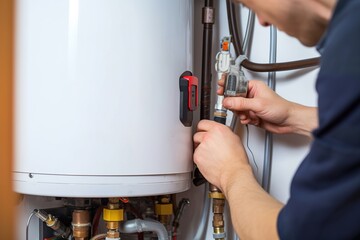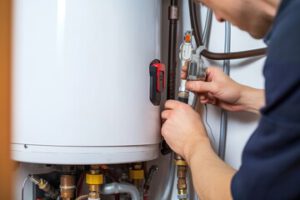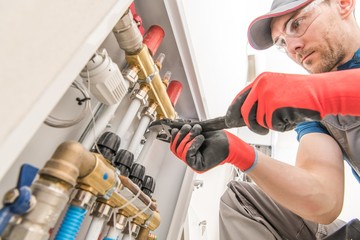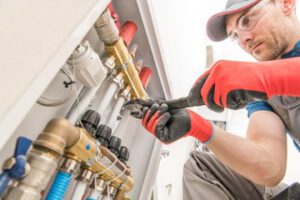Bryco Plumbing is the network of pipes, fixtures, and other apparatuses that convey fluids—mainly water—throughout buildings. Plumbers install, maintain, and repair these systems. They also design and layout plumbing networks.
To become a plumber, you typically need a high school diploma or equivalent and undergo an apprenticeship that includes classroom instruction and paid on-the-job training. You must also obtain a license to work independently.
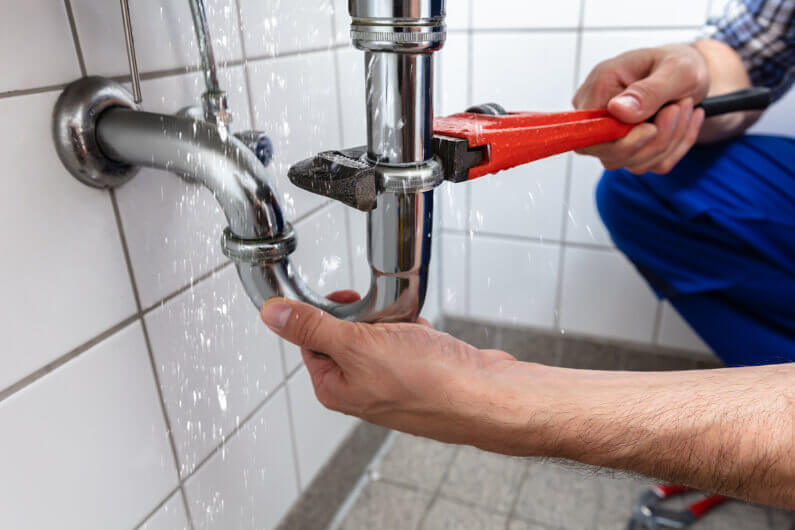
When most people think of plumbing, they envision their kitchen and bathroom faucets and fixtures. However, the plumbing system is much more than that. It comprises a network of pipes that bring clean water in and carry wastewater and storm runoff out.
The main water line brings freshwater into the home from a municipal supply or private well. It then travels to the water meter, where it is recorded for billing purposes. From there, the water is distributed to individual fixtures like sinks, toilets and showers via supply pipes. Water heaters are also part of the plumbing system, as they heat up and distribute hot water throughout the house.
A properly functioning plumbing system is essential to a healthy home or business. Regular maintenance can help prevent plumbing problems and ensure that all parts of the system are working correctly.
Plumbers use a variety of tools to inspect and maintain plumbing systems. These include video cameras for inspections, high-pressure water pumps for drain cleaning, and special tools to repair or join pipe materials.
Fixtures
Plumbing fixtures are devices that deliver water to the places where people need it most. They include sinks, toilets, tubs, showers and bidets. They also include appliances like dishwashers and laundry machines. Most are designed to be long-lasting and durable, using materials that resist erosion, corrosion and staining. These materials include ceramic tile, stainless steel, fiberglass and plastic. Most plumbing fixtures have drains in the bottom for water to evacuate and stoppers that can be manipulated to control or block flow of water.
Upgrading your home’s fixtures is a great way to improve the look of your interior and increase its value. New fixtures may also be more energy-efficient, saving you money on your monthly utility bills. When choosing new fixtures, consider their water-flow rate and gallons per minute (gpm) to ensure they are a good match for your family’s needs and the design of your home.
Many plumbing fixture manufacturers offer high-efficiency, low-flow options, which can help you reduce your household water usage and your utility costs. These products are rated with the WaterSense label and come in a wide variety of styles, finishes and colors to fit your interior decor. Your plumber can provide suggestions for efficient fixtures that will suit your home and budget. They can also show you a selection of quality products that have been tested and approved by independent laboratories. They can help you find products that will meet your installation requirements and pipe-sizing guidelines.
Drain Pipes
Drainage pipes collect wastewater from your sinks, showers, tubs, and toilets, channeling it into the main drainage pipe that leads outside the home. The main line is usually 4 inches in diameter and runs beneath the lowest level of your house to the municipal sewer or septic system.
Most residential drainage pipes are made of ABS or PVC plastic, but cast iron and orangeburg are also used in some homes. A plumbing professional can advise you about the best drainage pipe for your situation based on anticipated soil conditions and the expected load of wastewater.
The main drain line is typically sloped downward to promote the flow of waste water. It may be lined with a P-trap (S-trap for toilets) or a J-trap. The traps seal the drains and prevent the buildup of debris, thereby preventing clogged drains. A plumber can remove or replace the traps to clean a clogged drain.
Blocked drainage pipes can result in sewage backup, which poses health risks for the entire household. The trapped fecal matter can breed bacteria and fungi that can lead to respiratory issues, skin problems, and other discomforts. Getting your drains regularly cleaned can prevent this from happening and save you the cost of repair or replacement. Regular cleaning can also help keep your plumbing fixtures working efficiently.
Sewer Pipes
All of the drains in your house, from sinks to toilets and showers, connect to pipes that carry waste to the sewer lines. The sewer system transports solid waste and grey water to either a public sewage treatment plant or your private septic tank. This is why it’s important to understand what your sewer line is made of, and to limit the amount of debris you put down your drains.
Your sewer pipe can be made from a variety of materials, but the most common are cast iron and ABS (acrylonitrile-butadiene-styrene) plastic. Both are long-lasting and durable. However, over time, the corrosive qualities of cast iron can cause clogs and other problems.
Newer, more modern types of sewer pipes are available to reduce the risk of clogs and other issues. One example is vitrified clay, which is a more sustainable option because it is environmentally friendly and unaffected by the acids found in wastewater.
Regardless of the material, any pipe work should only be conducted by a licensed professional plumber. Typically, this means a licensed master plumber. Sewer work requires special skills and tools, as well as a different scope of insurance than regular plumbing services. It’s also very dangerous to do it yourself. Contact the Balkan Team to schedule a free assessment and estimate from a qualified NYC sewer contractor.
Water Heaters
Hot water is one of the most important conveniences in your home. We use it for showers, washing dishes, laundry, and other daily tasks. It takes a lot of energy to heat your water, though. Whether you’re looking to cut your energy costs, reduce your carbon footprint, or both, it’s worth upgrading to a more efficient water heater.
Traditional water heaters have been around for decades and come with an insulated tank that holds between 20 and 80 gallons of hot water. These units are powered by electricity, natural gas, or propane. They work by recording the temperature of water in their tanks, and when readings drop below a pre-set level, they kick into gear to warm up the water.
When you turn on your hot water tap, a sensor inside the unit detects incoming water and activates a gas burner or electric heating rods. The heater then sends the water to your faucet at the appropriate temperature. When the tap is turned off, the heater shuts off.
To determine the temperature of your water, locate the access panel on your tank (if you have a larger heater, this might mean removing two separate panels). Remove any insulation and a plastic cover, then use a screwdriver to carefully remove the thermostat. A red dial should be visible, and the temperature should read 120 deg-140deg F.
Plumbing Equipment
The equipment that plumbers use can vary depending on the type of plumbing work they do. For example, if they’re working on copper pipe, they may need tubing cutters to cut the material. If they’re installing push-to-connect fittings, they might need a special tool to connect the tubes securely. Plumbers also need a variety of wrenches, including adjustable wrenches, basin wrenches and faucet-valve seat wrenches. Finally, they need pliers with angled jaws to loosen and tighten nuts.
The job of a plumber requires critical thinking and problem-solving skills. They must be able to weigh options and come up with solutions that are cost-effective and safe for the environment. They also need to have good verbal communication skills to explain their work to customers.
Some plumbers attend vocational schools to learn the necessary skills for their careers. Others complete apprenticeship programs, which can last from two to five years. These programs allow plumbers to learn from experienced tradespeople and gain hands-on experience in the field. In addition to formal training, plumbers must have physical strength and stamina to lift heavy equipment and work on their feet for long periods of time. They should also have the ability to work safely in tight spaces. Wearing gloves and long sleeves can help protect plumbers from cuts and other injuries. Safety goggles and a hard hat are also essential for protecting the plumber’s eyes and head.

